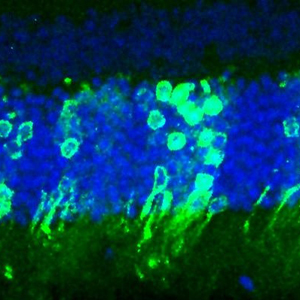Cure for Blindness, Macular Degeneration
Being able to see and enjoy all of the beautiful colors and various sights in life may be the greatest privilege that we take for granted everyday. Do we ever take the time to ponder what it would be like to live in darkness? Due to macular degeneration (loss of sight during old age) and other ailments, millions of people around the globe have to deal with this unfortunate truth. Millions of people are unable to see the faces of their loved ones, or a comfortingly familiar landmark or sunset.
Finding a cure for blindness has enthralled humanity for thousands of years. Fortunately, there have been several advancements in the field lately. Many involving a form of stem cell therapy, but others as foreign as using algae to revitalize our eyes. Still to this day, scientists have not discovered one definitive stop-gap measure to restore our vision. A major recent breakthrough could help lead us onto that path.
For the first time ever, scientists have successfully transplanted photoreceptors from healthy mice, into the eyes of visually impaired mice. Photoreceptors are abundant in humans and line the back of our eye sockets. Their main purpose is to help our brain interpret images when light lands on them. Just over a month after the groundbreaking procedure, the new photoreceptors actually grew into place, giving the blind mice the ability to see again. It is uncertain whether or not the test subjects were the famed three blind mice, but it is an impressive feat nonetheless.
There are two types of photoreceptor in the eye: rods and cones. This experiment dealt with replacing the rods in mice previously lacking some. The key was that these rods were immature, enabling them to sort of grow into the new socket. Rods account for approximately 95% of the 127 million photoreceptors in the human eye; they are responsible for helping us to see clearly in dim settings. The few cones that exist in our eyes are still of vital importance, as they are what enable us to perceive the full color spectrum. The next natural step would be to implant foreign cone photoreceptors into colorblind mice to attempt to achieve the same outcome.
This experiment has huge ramifications for those suffering from macular degeneration, retinitis pigmentosa (damage to the retina) and diabetes related blindness. Lead Researcher Professor Robin Ali at the University College London Institute of Ophthalmology said “We’re hopeful that we will soon be able to replicate this success with photoreceptors derived from embryonic stem cells and eventually to develop human trials.”
Not only does this have humongous ramifications for thousands of blind individuals, Professor Ali speculates that the “findings also pave the way for techniques to repair the central nervous system, as they demonstrate the brain’s amazing ability to connect with newly transplanted neurons.” Since the central nervous system involved the brain and spinal cord, that is an incredibly exciting proposition.
Will our children live in a world where a loss of one of the five senses is only temporary? Is every ailment known to man curable? If we can fix every disease plaguing us, how long can humans live for? Although these questions make for great banter, we’ll just have to wait and see.
Comments
Tags: blindness, blindness cure, cure for blindness, cure for the blind, curing blindness, macular degeneration, retinitis pigmentosa, stem cell therapy, stem cells
Trackback from your site.


